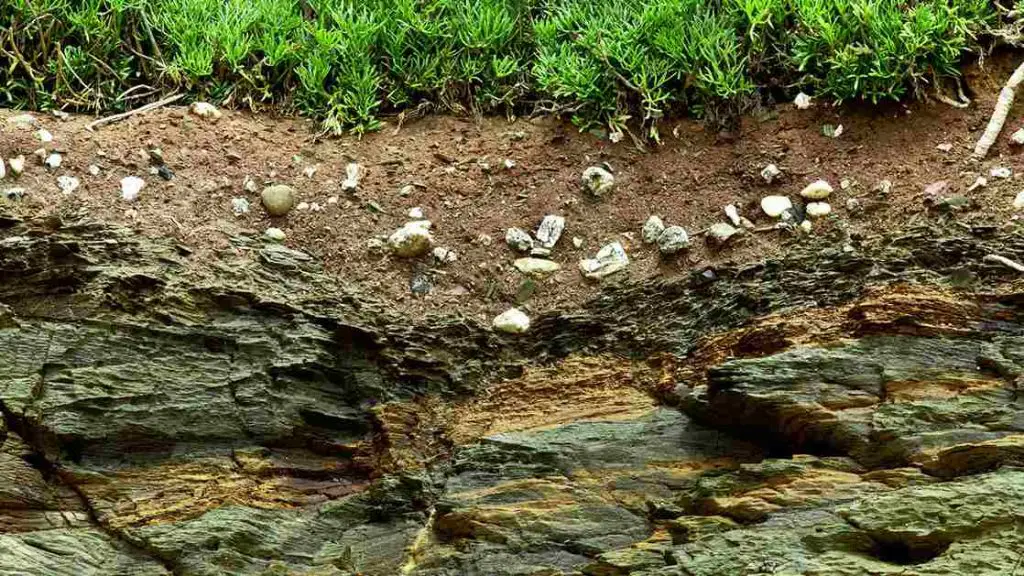We all know that rock turns into soil, but have you ever stopped to think about how that happens? In this blog post, we’ll take a look at the process of how does rock turn into soil and some of the factors that influence it. Soil is an important part of our lives, and it’s worth taking the time to understand more about it!
What Is Soil Made Of And Where Does It Come From?

Soil is a complex mixture of minerals, organic matter, water, and air. It forms the foundation of plant life on Earth and is essential for supporting healthy plant growth. But where does soil come from?
Soil formation is a long and complex process that involves the interaction of physical, chemical, and biological processes over time.
Physical processes include weathering and erosion, which break down rocks and other materials into smaller particles.
Chemical processes involve the transformation of these particles by acids and other chemicals.
Biological processes involve the decomposition of organic matter by bacteria and other organisms.
Over time, these processes work together to create the rich, diverse soils that we see today.
How Does Rock Turn Into Soil Over Time?
The process of rocks turning into the soil is called weathering. Weathering can happen in two ways: physical weathering and chemical weathering.
Physical weathering happens when the environment physically breaks down rocks. This can be done by water, wind, ice, or plants. For example, when it rains, the water seeps into cracks in the rock and expands when it freezes. This expansion breaks the rock apart. Wind can also break rocks apart by blowing sand against them. Plants can grow in cracks in rocks and over time they will break the rock apart as their roots grow and expand.
Chemical weathering happens when chemicals in the environment change the composition of the rock. For example, when carbon dioxide dissolves in rainwater it creates a mild acid. This acid reacts with many types of rocks, breaking them down into small pieces. Over time, these small pieces of rock turn into soil.
Benefits Of Fertile Soil For Plants And Humans Alike
Fertile soil is key to sustaining plant life, which in turn is key to sustaining human life. Fertile soil is packed with nutrients that plants need to grow, including nitrogen, phosphorus, and potassium.
The organic matter in fertile soil helps to retain water and prevents erosion. Fertile soil also supports a diverse range of microorganisms, which play an important role in decomposing organic matter and cycling nutrients.
In addition to being essential for plant growth, fertile soil is also important for human health. The nutrients in healthy soils are essential for human nutrition, and the microorganisms in soils help to protect against harmful bacteria and diseases.
As our population continues to grow, it is essential that we work to conserve and improve our limited supply of fertile soils.
Can Anything Be Done To Speed Up The Process Of Turning Rock Into Soil?
Weathering is the process of breaking down rocks into smaller pieces. Over time, weathering can turn a large boulder into a pile of gravel or sand. The rate of weathering depends on a number of factors, including the type of rock, the amount of moisture and wind, and the temperature.
Some rocks weather more quickly than others. For example, limestone is relatively soft and can be easily broken down by weathering. In contrast, granite is much harder and resistant to weathering. As a result, it can take centuries for granted to change into the soil.
There are several ways to speed up the process of weathering. First, you can use mechanical methods such as hammering or chiseling to break the rock into smaller pieces.
Second, you can use chemical methods such as acids or explosives to break down the rock. Third, you can use physical methods such as heat or cold to change the structure of the rock. Fourth, you can use biological methods such as plants or animals to break down the rock.
Each of these methods has its own advantages and disadvantages. For example, mechanical methods are quick and effective but can be dangerous if not used properly. Chemical methods are also quick and effective but can be harmful to the environment. Physical methods are safe but slow.
Biological methods are safe and effective but can take a long time. Ultimately, the best way to speed up the process of weathering is to use a combination of several different methods.
How Do We Protect Our Soil Resources For Future Generations?
One of the most important resources we have on Earth is soil. Soil provides us with food, fuel, and fiber and is necessary for the survival of all terrestrial plants and animals.
Unfortunately, this vital resource is under threat from a number of human activities. Urbanization, industrialization, and agriculture have all contributed to soil degradation, which is the loss of soil productivity due to its physical, chemical, or biological deterioration.
This degradation can lead to a decrease in crop yields, an increase in water pollution, and a decline in biodiversity. So how do we protect our soil resources for future generations?
There are a number of things we can do to conserve and improve the quality of our soils. One is to reduce the amount of land that is converted to urban or industrial use.
Another is to promote sustainable agricultural practices that minimize soil disturbance and erosion.
And finally, we need to increase our investment in research and education so that we can continue to develop new ways to protect this vital resource.
By taking these steps, we can ensure that our soils will continue to support life on Earth for generations to come.
Additional Contents


